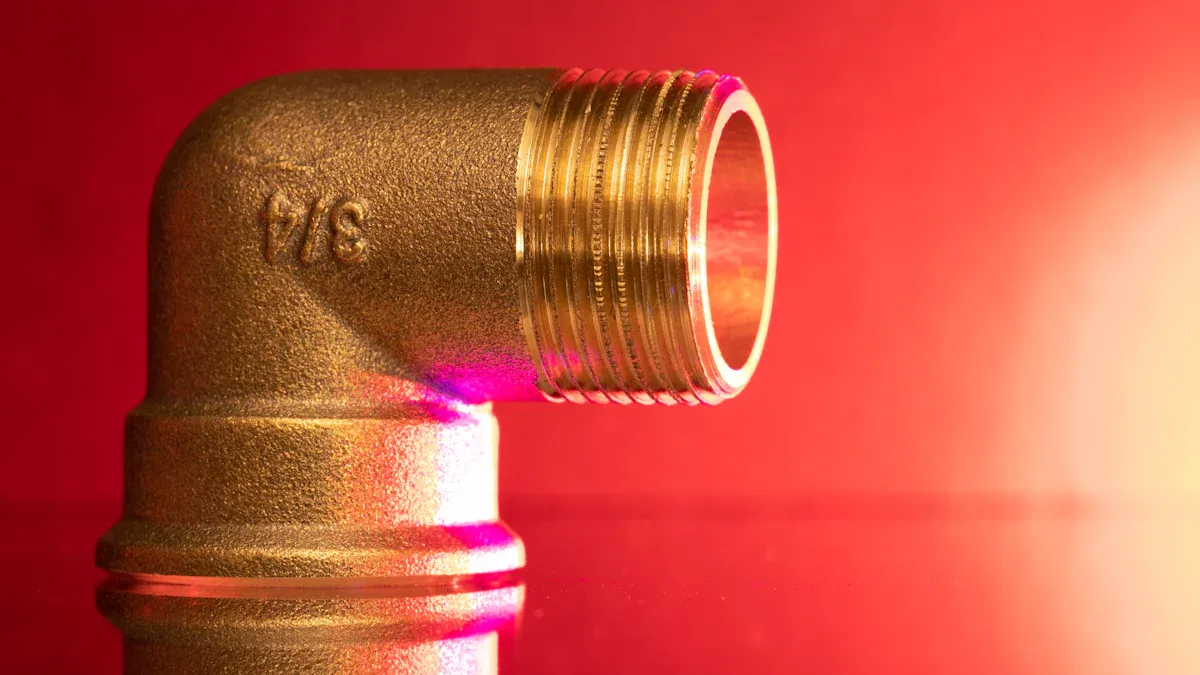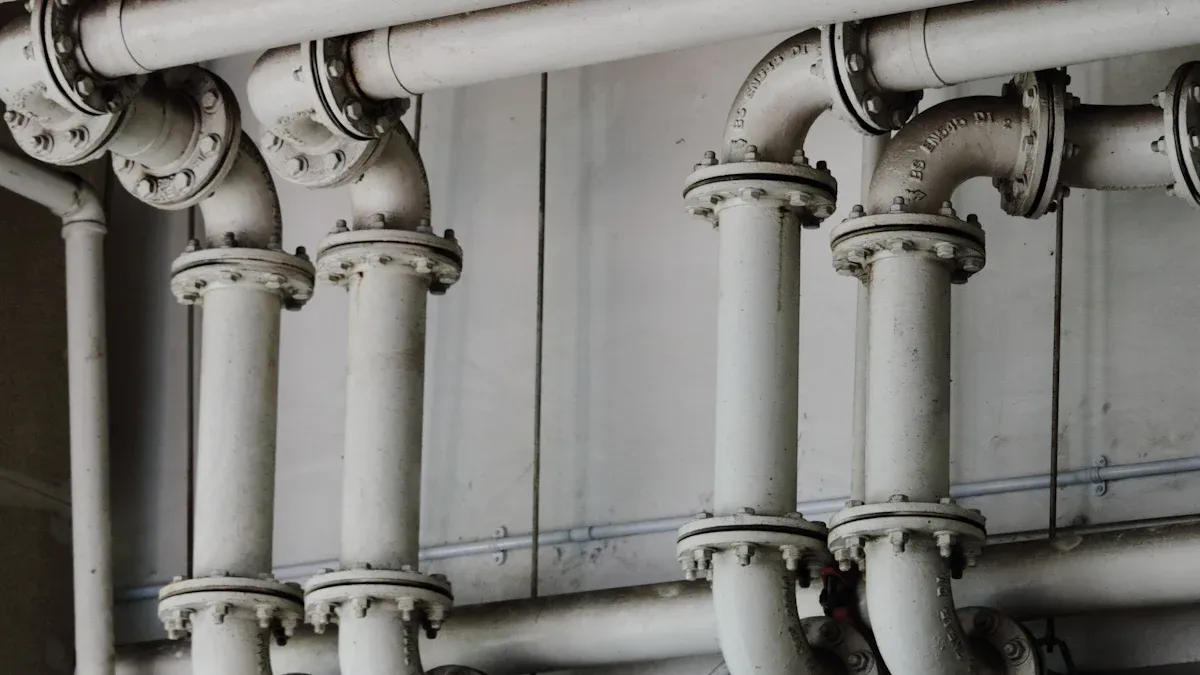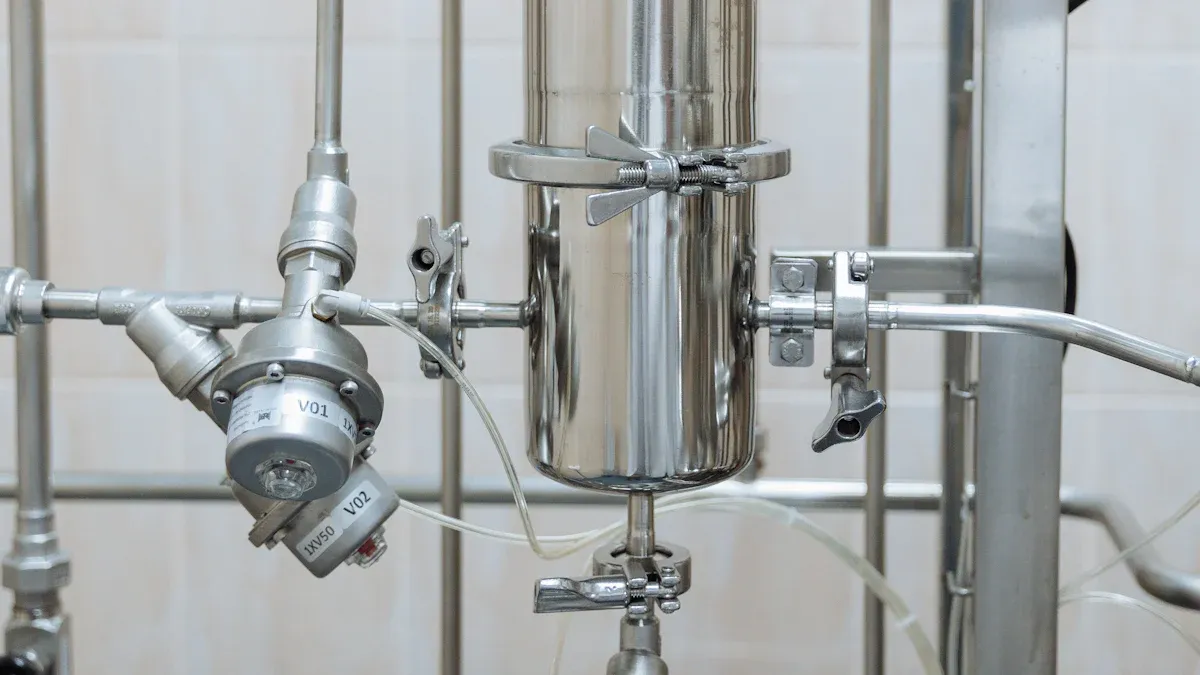
Choosing the right stainless steel precision castings for pipe fittings can make or break a system’s efficiency. Why? Because these stainless steel precision castings pipe fittings directly impact durability, safety, and cost. Understanding material properties like corrosion resistance, strength, and hygiene ensures that precision castings pipe fittings meet specific needs. Industries like oil and gas or food processing rely on these stainless steel precision castings to maintain safety and performance under demanding conditions.
Key Takeaways
- Learn about different stainless steel types. Use 304 for everyday uses and 316 for tough conditions. Knowing this helps pick the right material for your needs.
- Check what the job needs before picking castings. Think about things like rust resistance and strength to make sure it works well in hard situations.
- Match cost with how well it works. Spending more on better materials like 316 can save money later on repairs and replacements.
Overview of Stainless Steel Precision Castings
Definition and Characteristics
Stainless steel precision castings are components created using the investment casting process, known for its ability to produce intricate shapes with high dimensional accuracy. These castings are made from stainless steel alloys, offering exceptional corrosion resistance, strength, and durability. They can be polished to a mirror finish, which enhances their resistance to harsh environments, especially in marine or chemical applications. Unlike traditional methods, precision casting minimizes waste and eliminates the need for extensive machining, making it a cost-effective solution for complex designs.
| Alloy | Key Features | Applications |
|---|---|---|
| Stainless Steel 304 | Excellent corrosion resistance and formability. | Consumer electronics, telecommunication. |
| Stainless Steel 316 | Superior resistance in chloride-rich environments. | Marine equipment, chemical processing. |
| Stainless Steel 2205 | High strength and corrosion resistance. | Offshore structures, oil and gas industry. |
Importance in Pipe Fittings
Stainless steel precision castings for pipe fittings play a critical role in ensuring system reliability. Their high tensile strength allows them to withstand extreme pressures and temperatures, making them ideal for demanding industries like oil and gas. Corrosion resistance minimizes leaks and failures, while low maintenance requirements ensure long-term performance. These castings also meet stringent technical standards, ensuring safety and efficiency in pipelines and valves.
Common Manufacturing Methods
Several methods are used to produce stainless steel precision castings for pipe fittings:
- Investment Casting: Offers high precision and minimal waste, ideal for intricate designs.
- Centrifugal Casting: Produces uniform cylindrical parts with consistent material properties.
- Sand Casting: Cost-effective for large parts but less accurate.
- Pressure Die Casting: Best for high-volume production with excellent surface quality.
Each method has unique advantages, allowing manufacturers to tailor solutions based on application needs.
Key Factors to Compare Stainless Steel Precision Castings for Pipe Fittings
Material Composition
The material composition of stainless steel precision castings for pipe fittings determines their performance in various environments. Elements like chromium, nickel, and molybdenum play a significant role. Chromium forms a protective oxide layer, enhancing corrosion resistance. Nickel improves toughness, while molybdenum boosts resistance to pitting in chloride-rich conditions. For instance, CF8M stainless steel contains 2-3% molybdenum, making it ideal for harsh environments. Industry standards such as ASTM A744 and ASTM A182 ensure consistent material quality and performance.
Corrosion Resistance
Corrosion resistance is critical for pipe fittings exposed to moisture, chemicals, or saltwater. Stainless steel grades like 316 excel in chloride-heavy environments, while duplex stainless steels offer superior resistance to stress corrosion cracking. The addition of elements like molybdenum and copper further enhances this property, ensuring long-term durability in demanding applications.
Mechanical Properties
Mechanical properties like strength, flexibility, and hardness determine the reliability of stainless steel precision castings for pipe fittings. Austenitic stainless steels, such as 304 and 316, are known for their versatility and low magnetic permeability. Heat treatments like solution treatment improve ductility and toughness, ensuring the castings can withstand high pressures and mechanical stress.
Temperature Resistance
Pipe fittings often operate in extreme temperatures. Stainless steel grades like 304 and 316 maintain their structural integrity in both high and low temperatures. For applications requiring even greater heat resistance, grades like 310 or 2205 are preferred. These materials ensure safety and performance in industries like power generation and chemical processing.
Cost Considerations
Cost factors include the type of casting method, material grade, and heat treatment requirements. For example, stainless steel 316 is more expensive than 304 due to its molybdenum content but offers better corrosion resistance. Choosing the right balance between cost and performance is essential for optimizing budgets without compromising quality.
Applications and Standards
Stainless steel precision castings for pipe fittings are used in industries like oil and gas, marine, and food processing. Standards such as ASTM A240 and ASTM A276 ensure these castings meet strict requirements for safety and performance. Applications range from chemical pipelines to offshore structures, where reliability is non-negotiable.
Comparison of Popular Stainless Steel Grades

304 Stainless Steel: Features and Uses
304 stainless steel is one of the most widely used materials in stainless steel precision castings for pipe fittings. Its high chromium and nickel content provide excellent corrosion resistance, making it suitable for general-purpose applications. This grade is also known for its ease of fabrication and outstanding formability. Industries like food processing and household manufacturing often rely on 304 for its hygienic properties and durability. From kitchen sinks to industrial pipelines, 304 stainless steel delivers reliable performance in environments that demand cleanliness and strength.
316 Stainless Steel: Features and Uses
316 stainless steel takes corrosion resistance to the next level. Its molybdenum content enhances its ability to withstand harsh environments, especially those with high chloride exposure, such as marine or chemical processing industries. This grade also offers excellent weldability, making it a favorite for complex pipe fittings. However, it has slightly lower fluidity and higher shrinkage during casting due to its composition. Careful control during manufacturing ensures optimal results. The table below highlights some key features of 316 stainless steel:
| Feature | 316 Stainless Steel |
|---|---|
| Corrosion Resistance | Exceptional, suitable for harsh environments |
| Weldability | High, allows for easy fabrication |
| Fluidity | Slightly lower than 304, can be optimized |
| Shrinkage | More prone due to molybdenum content |
| Thermal Cracking Tendency | Higher tendency, requires careful control |
304 vs. 316: Key Differences
Choosing between 304 and 316 stainless steel often depends on the application. While both grades offer excellent corrosion resistance, 316 outperforms 304 in chloride-rich environments due to its molybdenum content. The table below compares their composition and performance:
| Metric | 304 | 316 |
|---|---|---|
| Chromium (Cr) | 18.00-20.00% | 16.00-18.00% |
| Nickel (Ni) | 8.00-10.50% | 10.00-14.00% |
| Molybdenum (Mo) | – | 2.00-3.00% |
| Corrosion Resistance | Good | Excellent (especially against chlorides) |
| Applications | Kitchen fittings, household items, food processing | Chemical and pharmaceutical equipment, marine environments |
304 is ideal for general-purpose use, while 316 is better suited for demanding conditions. Understanding these differences helps in selecting the right material for specific needs.
Other Grades: 430 and 2205
Beyond 304 and 316, other stainless steel grades like 430 and 2205 offer unique advantages. Grade 430 is a ferritic stainless steel known for its affordability and good corrosion resistance in mild environments. It’s commonly used in decorative applications and automotive trim. On the other hand, 2205 is a duplex stainless steel that combines high strength with excellent corrosion resistance. It’s perfect for offshore structures and the oil and gas industry, where durability under extreme conditions is critical.
Each grade serves a specific purpose, making it essential to match the material to the application for optimal performance.
Advantages and Disadvantages of Stainless Steel Grades
Pros and Cons of 304 Stainless Steel
304 stainless steel is a popular choice for many applications, and for good reason. It offers excellent corrosion resistance, making it suitable for environments with moisture or mild chemicals. Its high formability and weldability make it easy to work with, whether for intricate designs or large-scale projects. Plus, it’s cost-effective compared to higher-grade options.
However, 304 isn’t perfect. It struggles in chloride-rich environments, like coastal areas or chemical plants, where pitting corrosion can occur. Its lower resistance to extreme temperatures also limits its use in high-heat applications. For general-purpose use, though, 304 remains a reliable and affordable option.
Pros and Cons of 316 Stainless Steel
316 stainless steel takes durability up a notch. Its molybdenum content provides superior resistance to chlorides and harsh chemicals, making it ideal for marine and industrial settings. It also performs well in high-temperature environments and offers excellent weldability for complex designs.
On the downside, 316 is more expensive than 304. Its higher cost can be a drawback for budget-conscious projects. Additionally, its slightly lower fluidity during casting requires careful manufacturing to avoid defects. Despite these challenges, 316 is the go-to choice for demanding applications.
Cost vs. Performance Trade-offs
When choosing between 304 and 316, it’s all about balancing cost and performance. 304 is a great option for general use, offering good corrosion resistance at a lower price. But for environments with harsh chemicals or saltwater exposure, investing in 316 pays off in the long run.
Tip: Consider the specific application and environment before deciding. Spending a bit more upfront on 316 can save money on maintenance and replacements later.
Tips for Choosing the Right Stainless Steel Precision Castings for Pipe Fittings

Evaluating Application Needs
Understanding the specific requirements of an application is the first step in selecting the right stainless steel precision castings. Different environments and uses demand unique properties. For example:
- Forging is ideal for high-pressure systems due to its strength and durability.
- Casting works best for intricate designs, offering flexibility and precision.
Key factors like corrosion resistance, strength, and maintenance also play a role. Corrosion-resistant materials reduce the risk of leaks and failures, especially in harsh environments. High tensile strength ensures the fittings can handle extreme pressures and temperatures. Additionally, polished stainless steel offers aesthetic appeal and requires minimal upkeep. These qualities make stainless steel castings a reliable and eco-friendly choice for various industries.
Balancing Budget and Performance
Finding the right balance between cost and performance is crucial. While higher-grade materials like 316 stainless steel may cost more, they provide superior durability in demanding conditions. On the other hand, 304 stainless steel offers a cost-effective solution for general-purpose applications. Consider the long-term benefits of investing in quality materials. Spending more upfront can reduce maintenance costs and extend the lifespan of the fittings, saving money over time.
Tip: Evaluate the total cost of ownership, not just the initial price. This approach ensures the best value for your investment.
Checking Industry Standards
Industry standards ensure the quality and safety of stainless steel precision castings. Look for certifications like ASTM A240 or ASTM A276, which guarantee the material meets strict performance criteria. These standards cover aspects like corrosion resistance, mechanical properties, and temperature tolerance. Adhering to recognized standards ensures the fittings perform reliably under specific conditions, whether in chemical pipelines or marine environments.
Partnering with Reliable Manufacturers
Choosing a trusted manufacturer can make all the difference. Experienced suppliers offer customized solutions tailored to specific project needs. Their expertise ensures the castings meet performance expectations while maintaining eco-friendly practices. Reliable manufacturers also prioritize transparency, fostering trust and accountability.
Note: Collaborating with a skilled supplier can lead to innovative designs and sustainable solutions, enhancing the overall efficiency of your system.
By evaluating application needs, balancing costs, adhering to standards, and working with reputable manufacturers, businesses can confidently select the best stainless steel precision castings for their pipe fittings.
Choosing the right stainless steel grade for pipe fittings boils down to understanding their differences. Austenitic stainless steels, like 304 and 316, offer high corrosion resistance and moderate strength, making them versatile for most applications. Duplex grades combine high strength and corrosion resistance, ideal for challenging environments. The table below summarizes these distinctions:
| Type of Stainless Steel | Corrosion Resistance | Strength | Applications |
|---|---|---|---|
| Austenitic | High | Moderate | Widely used |
| Ferritic | Moderate | Low | Less demanding |
| Martensitic | Low | High | High strength |
| Duplex | High | High | Challenging |
When selecting stainless steel castings, consider factors like corrosion resistance, mechanical properties, and cost. For example, electric arc furnaces are cost-effective for large-scale production, while sand molds reduce expenses compared to glass molds. Heat treatments and alloy compositions also influence costs.
Tip: Consult manufacturers for tailored solutions. Their expertise ensures the right balance of performance, durability, and budget for your specific needs.
FAQ
What makes stainless steel precision castings better than other materials for pipe fittings?
Stainless steel offers excellent corrosion resistance, durability, and strength. It also requires minimal maintenance, making it a cost-effective and reliable choice for various industries.
How do I choose between 304 and 316 stainless steel for my project?
Consider the environment. Use 304 for general applications and 316 for harsh conditions like marine or chemical exposure. 316 resists chlorides better.
Can stainless steel precision castings handle extreme temperatures?
Yes! Grades like 304 and 316 perform well in high and low temperatures. For even greater heat resistance, consider grades like 310 or 2205.
Tip: Always consult with manufacturers to match the material to your specific needs.
